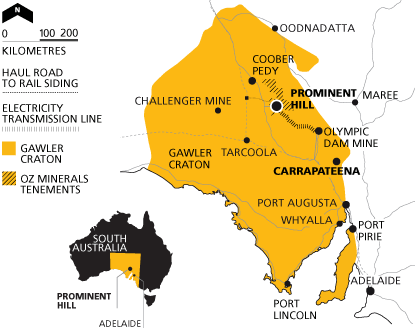Australian copper miner Oz Minerals Ltd says it is looking to solar power to help run a $1 billion Carrapateena copper mine it is proposing to build in South Australia, in what would be the biggest commitment to new energy technologies yet seen by a mining company in Australia.
Managing director Andrew Cole says the company could turn to solar power to help run the Carrapateena copper mine it is considering building, which is one of the largest mining project proposals in Australia at the moment.
According to an interview with Reuters, the considering of new technology follows the blackout that disrupted industry across South Australia last month and raised concerns over energy security.
A spokesman told RenewEconomy that the company has created a dedicated team to look at various energy options around the world. He said no conclusions had been reached, and no technology had been ruled in or ruled out.
 Mining companies in Australia have largely steered clear of deploying renewable energy on their mine sites, preferring to rely on the grid, or on-site gas and diesel plants. But there has been growing interest.
Mining companies in Australia have largely steered clear of deploying renewable energy on their mine sites, preferring to rely on the grid, or on-site gas and diesel plants. But there has been growing interest.
Sandfire Resources has installed a 10MW solar plant with 6MW of battery storage to reduce the amount of diesel it uses at its Degrussa mine in Western Australia, while Rio Tinto has a 1.7MW solar array at its Weipa mine which could be expanded to 6.7MW and battery storage.
And BHP Billiton has also expressed interest in solar and battery storage after buying into data from the world’s biggest solar and storage project planned for north Queensland.
A number of mines in Chile and South Africa have benefitted from large-scale solar installations, Reuters noted. The addition of storage could provide guaranteed supply in addition to guaranteed prices via long-term power purchase agreements.
Oz Minerals’ Prominent Hill copper mine and other projects, including BHP’s Olympic Dam copper mine, were badly affected by the South Australia blackout, and it is thought that big mines and other large energy users, as well as remote towns and communities, will look to more local generation and micro-grids as a way of ensuring energy security.
Carrapateena is located in the same region as Prominent Hill and Olympic Dam, where there are numerous solar projects being proposed, from the likes of DP Energy, from coal group Adani, from former executives of the owners of the Hazelwood brown coal generator, by Lyon Solar, and also Solar Reserve, which says there is a potential market for six large scale solar tower and molten salt storage plants.
Cole says he was looking at a number of alternative energy sources to support Carrapateena, not just solar, as the project takes shape over the next three years.
Prominent Hill is connected to the grid, and has diesel back-up generators that kept the open pit mine operating, but the company was forced to stop processing.
“What they (Sandfire) have done is really innovative,” Cole told Reuters in the interview. Not that he was suggesting that the mine go solar and storage only. Sandfire’s solar and storage reduces the amount of expensive diesel that is required.
“You cannot run any mine off grid with just solar,” Cole said. “Until we have very good power storage solutions, renewables will always need to be complemented by sufficient base load.”










